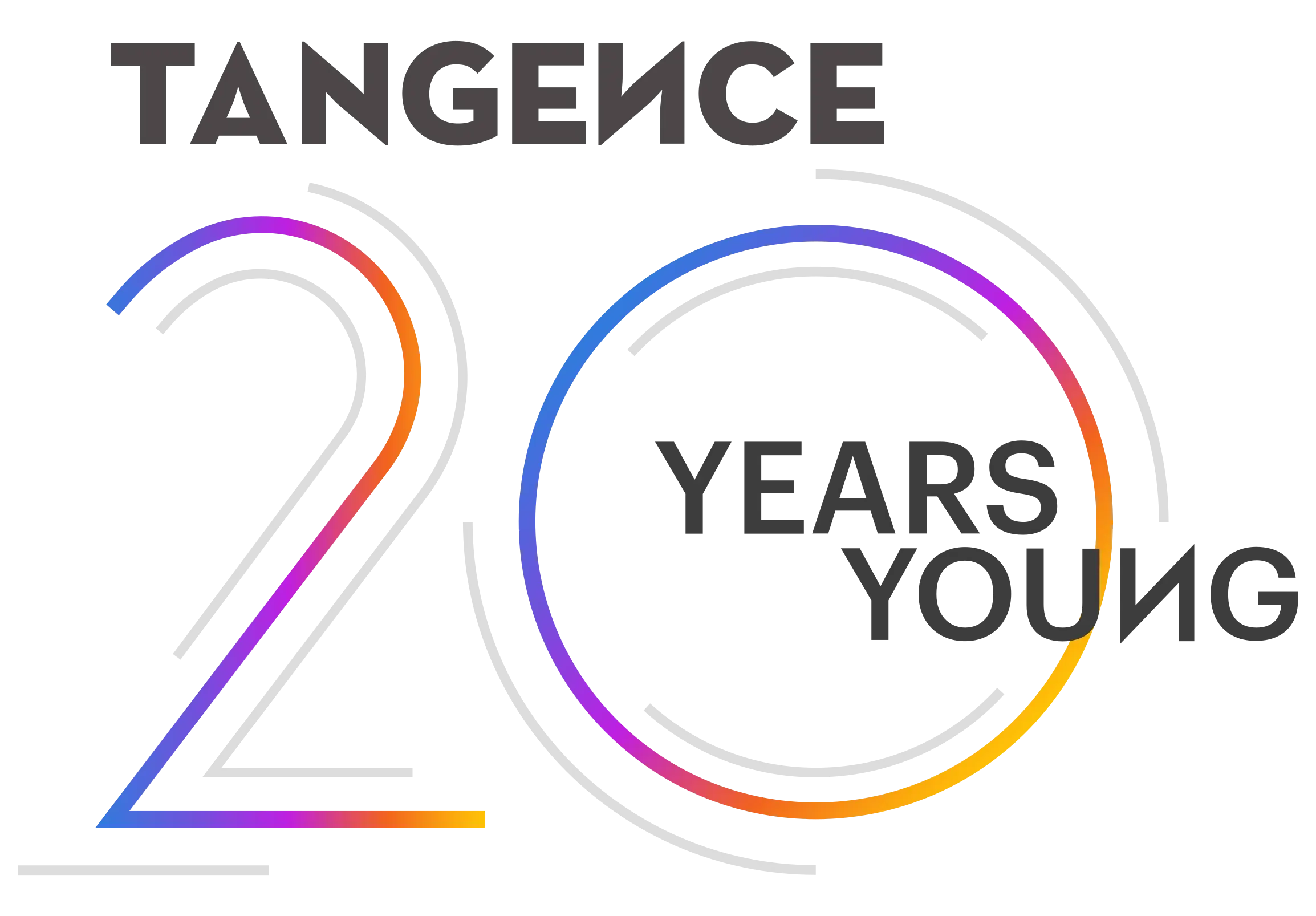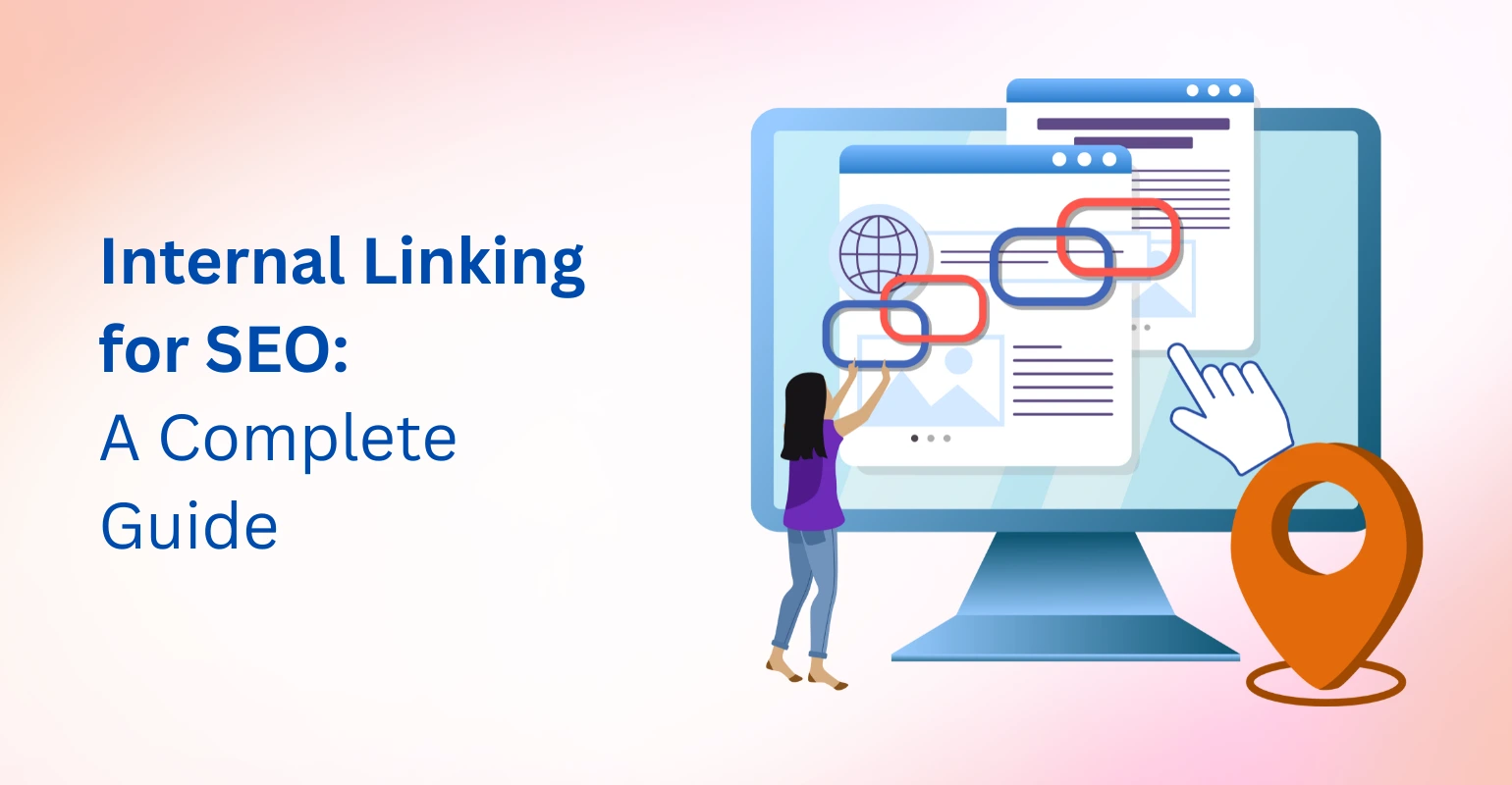blog
AEO in 2025: How Answer Engine Optimization is Changing SEO Forever
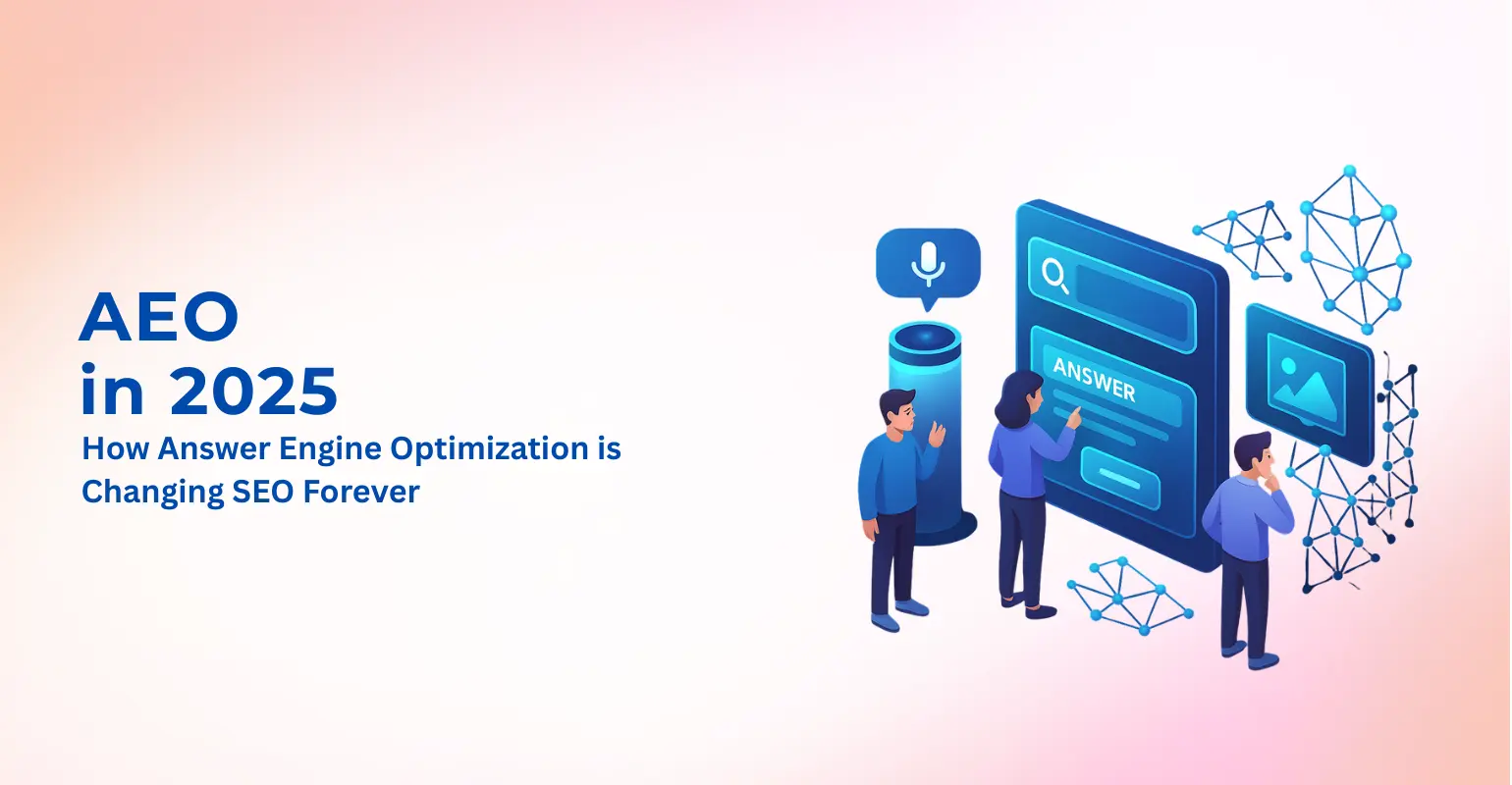
The Evolution from SEO to AEO
The world of search is changing rapidly. Traditional Search Engine Optimization (SEO), which focused on ranking high in search results, is no longer enough. Today, users expect direct, reliable answers from search engines.
This shift has given rise to Answer Engine Optimization (AEO), a strategy focused on making content discoverable by AI-powered tools like Google’s AI Overviews, ChatGPT, Bing Copilot, and voice assistants.
With more than 65 percent of searches ending without a click, the priority has shifted from ranking first to becoming the answer. In 2025, brands that ignore AEO risk becoming invisible—even with high-quality content.
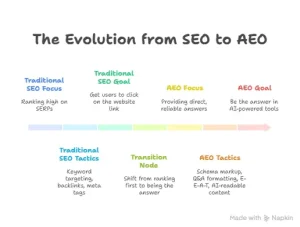
Image Source: Created using Napkin AI
What is Answer Engine Optimization (AEO)?
AEO is the practice of optimizing digital content so that it can be extracted and displayed as a direct answer by search engines, AI tools, and voice assistants.
Unlike traditional SEO, which aims to rank pages, AEO focuses on:
- Answering intent-based queries clearly and concisely
- Structuring content for featured snippets, People Also Ask sections, voice search, and AI-generated summaries
- Using schema markup to help search engines understand and trust the content
Example 1:
When searching for “What is PPC?” on Google, the featured snippet from Search Engine Land offers a concise, clear answer. This is a successful example of AEO in action.
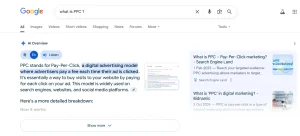
Image Source: Screenshot from Google Search for “What is PPC?” taken on July 1, 2025.
Why AEO Matters in 2025
Search platforms are evolving into answer engines. Google’s AI Overviews deliver synthesized answers directly on the search results page. Unless your content is structured for AEO, it may not be featured—no matter how good it is.
Key Data Points:
- 65% of searches are now zero-click (Source: Sparktoro, 2024 update) — showing how fewer users click through to websites, making AEO more critical than ever.
- Featured snippets receive nearly double the click-through rate compared to standard results (Source: Semrush, 2023)
- Voice search adoption continues to rise, especially on mobile devices
Case Study: Semrush Semrush restructured over 150 blog posts using AEO techniques:
- Incorporated FAQs and schema markup
- Turned headings into specific questions
- Placed clear, 50-word answers at the beginning of sections
Results:
- Over 200 keywords began triggering People Also Ask panels
- 35 percent increase in click-through rate from zero-click search results
- Tripled their number of featured snippet placements
How to Optimize Content for AEO
AEO is accessible to businesses of all sizes. Here’s how to begin:
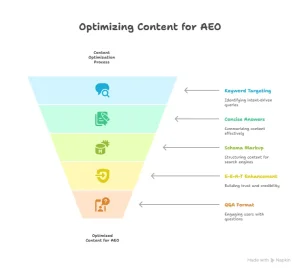
Image Source: Created using Napkin AI
1. Target Question-Based Keywords
Use tools like Semrush, AlsoAsked, and AnswerThePublic to identify common questions related to your niche. Optimize your content around these specific queries.
Example: Instead of “digital marketing pricing,” use “How much does digital marketing cost in India?”
2. Provide Clear and Concise Answers
Write direct answers within the first 40 to 60 words of each section. Follow up with deeper context or examples.
Example: Investopedia starts most articles with a brief definition, making it highly visible in AI search tools.
3. Use Schema Markup
Implement structured data such as FAQ, HowTo, and Article schema. This allows search engines to identify the purpose and format of your content.
4. Enhance E-E-A-T (Experience, Expertise, Authoritativeness, Trust)
Ensure that your content:
- Is written or reviewed by experts
- Contains references or citations
- Includes updated timestamps
- Has a transparent editorial process and author profiles
5. Use a Q&A Format
Frame subheadings as natural-language questions and provide clear, fact-based answers. This format is ideal for voice search and AI engines.
Want expert help implementing AEO strategies like schema markup, FAQ structuring, and question-based SEO? Explore our SEO Services to get started with AI-ready optimization.
| Tools | Purpose | Special Feature |
|---|---|---|
| Semrush | Keyword and snippet optimization | “Questions” filter in Keyword Magic Tool |
| AlsoAsked | Visualize question trees | Reveals query intent clusters |
| ChatGPT / Gemini | Simulate AI summaries using your content | Helps assess extractability |
| Schema Markup Generator | Add JSON-LD for FAQs and HowTos | Google-rich result compatibility |
| AnswerThePublic | Discover searcher questions | Ideal for long-tail content planning |
Common AEO Mistakes to Avoid
Avoid these pitfalls when optimizing for AEO:
- Using keywords without providing actual answers
- Ignoring featured snippet formatting
- Failing to implement structured data
- Overlooking authorship or expertise signals
- Writing long, dense paragraphs without clear structure
The Future of AEO: What to Expect
- Content will be treated as data by AI models, not just as text
- Voice-first SEO strategies will become essential
- AI search tools will favor content that is directly extractable and reliable
- Retrieval-Augmented Generation (RAG) models will fetch data from brand blogs and structured sources
As AI continues to evolve, optimizing for AEO will ensure that your brand’s content is selected, trusted, and displayed by default in AI and voice interfaces.
Top Industries Using AEO in 2025
Answer Engine Optimization (AEO) isn’t limited to tech giants or marketing agencies. Several industries are actively leveraging AEO to boost visibility, drive brand authority, and appear in AI-generated answers. Here are five top sectors applying AEO with real-world success stories:
1. Healthcare & Medical
Why AEO Works: Patients search for symptoms, conditions, treatments, and doctor recommendations using voice assistants or AI tools like Google’s AI Overviews.
Case Study – Mayo Clinic: Mayo Clinic structured hundreds of condition-specific pages using FAQ schema and short answer blocks. For example, their “What is diabetes?” page appears in both Google featured snippets and ChatGPT answers due to clear definitions, trusted sources, and concise formatting.
Result: 40% increase in visibility on voice searches and a top spot in AI-generated health responses.
2. Legal & Compliance
Why AEO Works: Users search questions like “How to get a legal heir certificate?” or “What is anticipatory bail?”—queries that demand direct, legally accurate responses.
Case Study – Vakilsearch: Vakilsearch optimized its legal blog using question-based headers, short definitions, and HowTo schema. For the query “Difference between legal heir certificate and succession certificate,” their page appears in both Google featured snippets and Gemini responses.
Result: 25% growth in organic traffic from zero-click searches.
3. Finance & Fintech
Why AEO Works: People ask financial questions like “What is an SIP?” or “How to file income tax returns online?”
Case Study – Groww: Groww redesigned their blog posts to open with a 40–50 word summary, structured FAQs, and well-cited content. Their article “What is ELSS?” appears as the top snippet on Google and is commonly quoted in AI responses.
Result: 3x increase in snippet wins and 50+ keywords now rank in “People Also Ask.”
4. Education & EdTech
Why AEO Works: Learners use AI and voice assistants to understand concepts or find prep tips: “What is the Pythagorean theorem?” or “How to prepare for NEET?”
Case Study – BYJU’S: BYJU’S uses a Q&A format and short conceptual explanations with schema markup. Their foundational concepts like “What is Newton’s first law?” are indexed as featured snippets and commonly shown in ChatGPT responses.
Result: 30% rise in visibility in AI tools like ChatGPT and Gemini, particularly for foundational learning terms.
5. E-commerce & Retail
Why AEO Works: Consumers look for quick product info: “Best headphones under ₹2000,” “How to choose laptop for gaming,” etc.
Case Study – Amazon India: Amazon’s product pages and guides use structured product FAQs, concise descriptions, and user-generated Q&A—optimized for AEO. Many of these answers are featured in Google’s “People Also Ask” and AI Overviews.
Result: Increased “zero-click” visibility and higher trust signals for product-specific queries.
Conclusion: From Ranking to Responding
Answer Engine Optimization is more than a new acronym, it is the foundation of modern digital visibility.
With the rise of zero-click searches, voice-driven interfaces, and AI-generated answers, traditional SEO alone is no longer sufficient. Brands must create structured, trustworthy content that answers real questions in real time.
Start by:
- Rewriting one blog post with FAQ schema
- Adding direct answers to key subheadings
- Targeting intent-rich, question-based keywords
In 2025, SEO isn’t just about rankings—it’s about delivering answers.
Partner with our SEO experts to optimize your content for AI, zero-click results, and voice search.
Frequently Asked Questions About AEO
Q1. What is AEO in SEO?
AEO, or Answer Engine Optimization, is the process of making content structured and accessible so that search engines, AI tools, and voice assistants can use it to answer user queries directly.
Q2. How is AEO different from traditional SEO?
Traditional SEO focuses on rankings and traffic. AEO is about providing concise, structured answers that can be used by AI models and shown in rich snippets or voice search.
Q3. Why is AEO important in 2025?
With Google’s AI Overviews and increasing zero-click searches, your content needs to be answer-ready to appear in results. AEO ensures it can be featured, even if users never click through.
Q4. What types of content are best for AEO?
FAQ sections, how-to guides, definition pages, and any structured content that provides direct, useful answers.
Q5. What tools can help with AEO?
Semrush, AnswerThePublic, AlsoAsked, Google Search Console, Schema Markup Generators, and AI content testing platforms like ChatGPT or Gemini.
